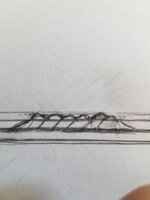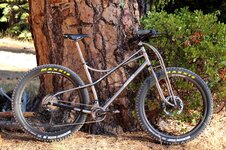@Fast n' Furious my frame's external dimensions show the seatpost centered, but the mounts for the motor are offset to the side and when you install the motor, the motor sits flush with the frame on the drive side and sticks out ~2cm on the non-drive side. There is a plastic cover that came with the motor for the non-drive side that screws into the frame and covers the nuts and washers of the 3 bolts that secure the motor to the frame, and provides a little 'easy' cable access when removed.
Here's the good stuff. Nice and centered
Here from Bafang's website you can see the bracket and how much the motor protrudes on the non-drive side, along with that plastic cover
View attachment 123888
Here you can see how the motor fits up with a frame. The seatpost isn't full centered (to the outer dimension) but the flanges in the bracket are still way offset for the motor to keep the chainline correct. The Ti frame pictured probably just has a little extra on the non-drive side that the plastic cover fits into. If anything providing better splash protection.
View attachment 123891
I'm too lazy to post pictures of the motor itself - since it's time to go play outside (on my legs... since I don't have my X1 motor yet...) but here's a link to a Frey review of the motor with the best pics I could find that show how dramatic that offset for the mounting points are
http://frey-bafang.patransformers.com/2020/06/28/bafang-ultra-max-m620-review/
I would also recommend to anyone and everyone who wants to easily remove their motor for service down the line to pop those mounting bolts out and slather them in some carbon safe grease like Crystal White Lightning then reinstall - more of a sidenote I guess only tangentially related, but... totally relevant lol
Thank you.
I understand. 'Offset', yes. Like these quality titanium M620 frames - and I threw in a Luna bracket.
Then we have the pic I previously posted .....
And the hole for the fender is perfectly centered for the wheel, accurately in the middle of the mount.
Shouldn't that line be on the center of gravity ?
Well, I guess moving the frame seat tube over on the mount bracket
could work and if the off-side seat-stay's too long on one side, no worries, weld it anywhere it'll fit - welds that lumpy, no one will notice anyway.
I'm just a picky bastard.
-
Why do I need 'carbon safe grease' on my titanium bike?
But even if I did have a CF bike
, (C4) Carbon is indestructible by
any reasonable chemical means - though many
types of 'grease' will even attack polyester - but polyester is all I hear CF frame makers using, even though it's weak and turns brittle ?
Okay, lets get greasy: For a Carbon/ Plastic bike, I think for conditions under 500f, a PTFE based grease would be the best option.
I've used PTFE grease and reused PTFE seals in +450F in settings, with no effect on the PTFE.
Finish-Line Premium PTFE (no lithium) is decent stuff. Nothing in there that will corrode your plastic parts (more than any other petroleum based compound).
White Lightning replaces lithium (harmful to plastic/ rubber) - but evidently great for psychotics) with aluminum.
That's helpful, but PTFE is inert and slippery, releasing parts quite well.
-
Titanium certainly doesn't need a powdered lower galvanic scale metal - to corrode- on it's lubed faces.
That's the very stuff that freezes metal together, not eases it's parting.
The next highest metal on the galvanic scale (cathodic), after (Number 35) titanium is (36) gold.
Of all 38 metals (Anodic), aluminum is number 4.
But yeah. If your casing if exceeding 500F, go metallic based for sure - maybe carry a fire extinguisher.
Anecdotally, reliable in-action vids, show a local here running a bumped up G510 to extremes for several miles and can still put his ungloved mitt on the cover when it's hot.
I appreciate material science data because not knowing what'll harm my materials, I can't possibly identify products that contain it -- that's why I know virtually
any long chain hydrocarbon, especially aliphatic, but aromatics as well (like Benzene, Toluene), will dissolve polyester resins.
As an aside, data on hydrocarbon contact 'degradation of CF matrix' is scant - because there's nothing to test. We know what dissolves plastics.
What type of plastic resin a CF frame is made made from is the question I'd need answered.
Epoxy's relative strength can hold up to 2,000 lbs. per square inch
Polyester? Less than 500 lbs. psi. How many lbs psi impact do you generate riding?
1.46667 ft/s = 1 mph. You may be hitting a lot harder than you think on both horizontal and vertical plane at once.
You like math. Terminal impact can be determined by solving for v, Where final velocity (v) equals the square root of initial velocity (u) squared plus two times acceleration (a) times displacement (s). v=√u2+2as.
We used to say velocity squares, mass doubles
Acceleration? An object dropping 1ft will reach a velocity of 8.02 feet per second (ft/s). An object dropping 4 ft will produce 16.04 ft/s
I'm not extolling titanium, but it suits me. On a titanium bike, premium welding is a must. Like this - and there's the offset
Built into the mount.
Hope this clarifies.
Fn'F
![20220524_125909[1].jpg 20220524_125909[1].jpg](https://forums.electricbikereview.com/attachments/20220524_125909-1-jpg.124168/)


